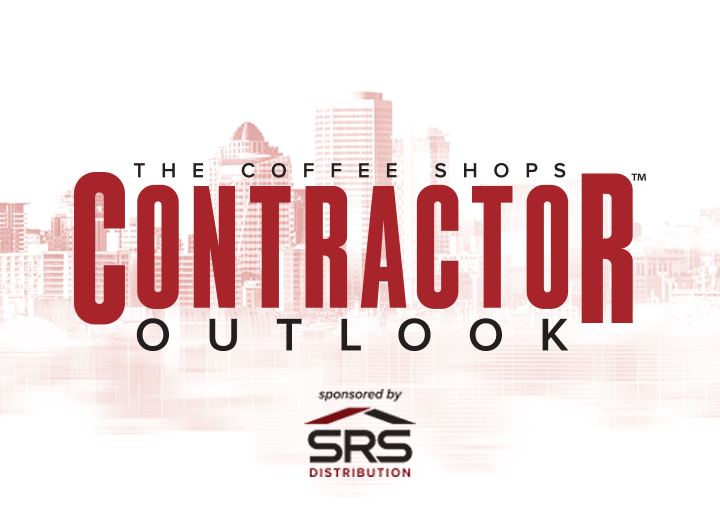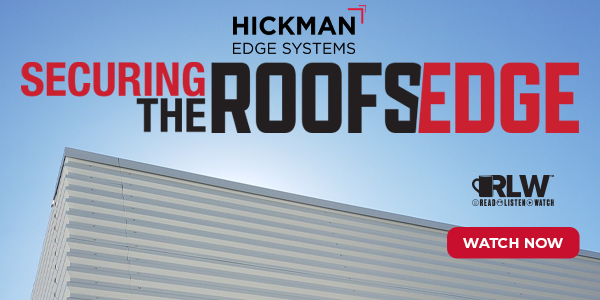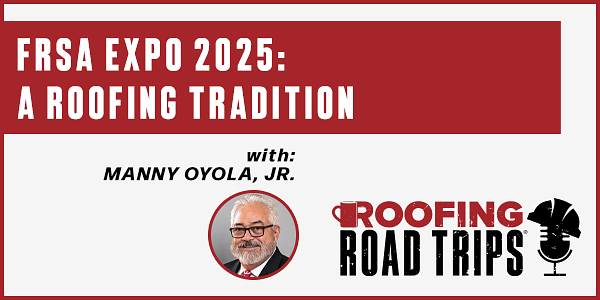Securing the Roof’s Edge - PODCAST TRANSCRIPT
July 11, 2025 at 11:00 a.m.Editor's note: The following is the transcript of a live interview with Hickman Edge System's Director of Private Label and OEM, Jason Hildenbrand. You can read the interview below, listen to the podcast or watch the recording.
Intro: All right, let's get started. Hi Jason, how are you?
Jason Hildenbrand: Hey, Megan Ellsworth. Good. How are you?
Megan Ellsworth: I'm so good. I'm excited to be talking with you today about securing the roof's edge, the drip edge. It's so important in a roof system. And, this is going to be a great conversation. It's brought to us by Hickman Edge Systems, so thank you so much for chatting with me today and being a part of it.
Jason Hildenbrand: Yep. Happy to be here.
Megan Ellsworth: Let's just have you start out by introducing yourself. Tell us a little bit about you.
Jason Hildenbrand: Sure. I'm Jason Hildenbrand. I'm the director of private label and OEM sales for Carlyle Architectural Metals. Carlyle or CAM is the parent company of our portfolio of brands. So Peterson Aluminum, Patclad, Drexel Metals, Metallera, Hickmanand also Citadel Architectural Products. Basically, I oversee our strategic partnerships across those brands and work on development and execution of different private label initiatives, OEM programsand co-branded sales channels. Been in the industry for 20 years. I started with OMG in 2005.
Megan Ellsworth: Wow.
Jason Hildenbrand: I was a field technician with OMG for a few years. I was also a regional manager in the Midwest. And then, had the opportunity to move down to Asheville, North Carolina to work in the Hickman business. So I've been really on the metal side for two thirds of that 20 years.
Megan Ellsworth: And it's the best side. I love metal.
Jason Hildenbrand: It sure is.
Megan Ellsworth: Amazing. Well, thank you for sharing. I'm just so excited to have someone like you with all the knowledge that you do have to be chatting with me today, so I'm really excited. Let's dive right in.
Jason Hildenbrand: Okay.
Megan Ellsworth: Let's start out by just give us kind of the lay of the land. What is edge metal and where is it used?
Jason Hildenbrand: Yeah, so perimeter edge metal, it's essentially the termination and transition between the roofing membrane and other building envelope components. It can be a parapet, it can be a roof edge or even a flow over edge condition, a coping, a fascia, drip edge, various flashings and of course, gutter. The key is really having a system that is applicable to the condition and properly securing the membrane at the perimeter. And we'll talk a little bit, I think, about the importance of that and what some of those things are. But that's really what it is. In it's basic terms. It's the edge of a building, whether it's a parapet, whether it's a direct edge or a flow over, something like that.
Megan Ellsworth: Yeah, thank you. That's fabulous. So why would you say is the roof edge a failure hot spot during a storm?
Jason Hildenbrand: Yeah, really, we know from decades of research and data that the roof edge itself is really the most vulnerable part of the building envelope, because that's the area where the roof and the wall transition is subject to the highest pressures. Unfortunately, the number and severity of weather incidents continues to increase. In the past two years, there have been 46 states that have experienced billion-dollar loss events and that's significant. And, it's five times more billion-dollar events than in the past 20 years and even in the previous two decades before that.
Megan Ellsworth: Yeah.
Jason Hildenbrand: Storm damage can be significant and the industry projections indicate that those losses are going to double in the next 10 years. So it's something we need to be accountable for and make sure we're addressing in that envelope design and the roofing installation.
Megan Ellsworth: Yeah. Wow, that's massive. I was doing The Weekly Blend this morning with Karen Edwards and she mentioned that you all have this really great example of a roof that had great edge metal and it was installed properly and had all the right things going on and then a roof that didn't and the difference between the two after a storm was just mind-boggling. Can you talk a little bit just about that?
Jason Hildenbrand: Yeah. So we actually have a real-world example, there's two buildings that were adjacent to each other. And, one of the buildings was re-roofed and installed with a extruded edge system and code-compliant material warranted. About 30 days after that installation, an EF3 tornado came through the area. And, when you look at the photos, it's pretty telling, because one of the buildings, the building that was not re-roofed, basically ended up looking like open storage. And, you can see actually the membrane that had been pulled off was in the power lines behind it. The building that had been re-roofed within that 30-day period was able to weather that storm. The membrane stayed intact, because the perimeter edge metal protected it. And outside of some minor damage to the membrane because of debris and things like that, that building was essentially able to stay intact. The folks from the building that was damaged actually sheltered in the newly-roofed building and everybody came through it by being able to shelter in that building. So yeah, it's a very impactful story.
Megan Ellsworth: Wow. That is. That's really impactful, especially with an EF3 tornado. That's not chump change. That's a big storm.
Jason Hildenbrand: Absolutely.
Megan Ellsworth: Wow. I'm so glad I brought that up and that Karen mentioned that to me. What a great story. So what are the mechanics of how it helps resist wind uplift?
Jason Hildenbrand: Yeah. So it's really about how wind reacts on a building. As wind approaches the building, it's going up, down, around the sides and everything and we're really talking about the vortices that are created and the increased pressure that is at the perimeter and corners. Minor differences in wind speed can have a pretty significant result on the force that's exerted on the roof, because as that wind uplift pressure increases exponentially with the wind speed. So at two times the wind speed, the pressure is actually 4X what it was previously. At 3 times, it's 9. At 4 times, it's 16. So you have those increased pressures in those areas that we need to make sure that we're accounting for.
It's the same reason that we have perimeter and corner wind zones on a roof, right? It's designed to protect those areas that are most subject to the pressures. Same is true for the perimeter edge. In most cases, when we see a roof failure from a storm or wind event, it starts at the edge and when that edge fails, the rest of the roofing components really can't withstand those loads and that's the importance of evaluating and making sure we're capturing that and designing and installing for that.
Megan Ellsworth: Absolutely. Yeah, that's huge. I just want to remind everyone the chat is open, so if you're having any questions come up, please pop them in there or in the Q&A section and we will get to them throughout the conversation today. This is really great stuff. So the next slide is really interesting and that is, tell us what happens when edge metal fails. And we have some examples here that you all gave us. Let's go into these.
Jason Hildenbrand: Yeah. So obviously, if the perimeter metal is loosened or damaged by the wind, as I said, the damage or failure of the rest of the roof is really inevitable.
Megan Ellsworth: Yeah.
Jason Hildenbrand: Most roof failures involve improperly designed or installed edge metal and when the roof is then damaged or destroyed, that loss is compounded with building components certainly, moisture on top of the building, other contaminations and things. There are really countless studies and examples from folks like Rikawi and FM, but also, like AIG, IBHS and others that are showing really the cost impact of these failures.
Speaking of examples, we have a study from AIG that there was about 7,000 square feet of roof covering loss and this was not a direct impact of a hurricane. It was on the outer bands of it. But, the cost to repair that, just the roofing cost was about $70,000. There was also a $1.7 million content claim and a $1.7 million business interruption claim. So what happens when the edge metal fails and the roof itself fails? I mean, we're talking about $4 million in loss that was reported by the AIG adjusters in this case. And what they reported back was that proper flashing securement would've likely resulted in no loss. And when you look at it, a roof is generally 10% of the building cost. The perimeter edge is 1% of that. So 1% to have a tested code compliant warranted system to avoid a $4 million potential liability is really cheap insurance, right?
Megan Ellsworth: Yeah. Yeah. No, that really is. And so, for contractors out there listening to this, what are some next steps to ensuring that their edge metal isn't failing?
Jason Hildenbrand: So I think there are several options. I mean, obviously, from my perspective, I would prefer that they went with a pre-engineered option, right? But, there are certainly really looking at the testing options for it and making sure that the edge system that's applied to whatever project is compliant with that testing and can meet those pressures. And there's multiple ways to do that, from independent testing agencies. NRCA has their own testing through both UL and Intertech. The contractors can work with. Some membrane manufacturers have their own programs where they can authorize contractors to fabricate tested systems and give them that compliance. That's really the best way we can do it, is to make sure that we're mitigating that risk as much as possible and having a tested system that how it's going to perform is really the best way to do that.
Megan Ellsworth: Yeah, yeah. I mean, a good point. And, in that way, I mean, if you do go pre-engineered, you're not messing with it on the site, right? It's ready to roll, you install it, 1, 2, 3, boom.
Jason Hildenbrand: Right.
Megan Ellsworth: Okay. So let's talk about codes and standards right now, because I know things are constantly changing. You mentioned there's new gutter codes, all that stuff. So let's dive into this.
Jason Hildenbrand: So important point to hit first, ES-1 is a test standard, it's not a certification. I'll get back to that in a minute. But ES-1 is basically the code language that governs testing of perimeter edge metal. It's been in code since 2003. The developments really started several years before in response to hurricanes and damage to buildings due to storms. And with that increase, we've seen revisions over the years from design pressure calculations from ASCE to actual changes to the testing methods based on real world applications and lessons learned. Back to the certification, it really has to do with the product that was tested and on the project it's being applied. So if I'm designing and installing an edge metal system for the hotel I'm sitting in right now, that's going to be different. The design pressures on that are going to be different and the requirements on that are going to be different than the hospital down the street or the gas station that's next door here.
So it really depends on what the project is and what product we're looking to install. It's not a blanket approval. One of the key things from a contractor standpoint is documentation. All of these agencies that perform testing will provide documentation. So it's easy for anyone to see that documentation and say, "Yeah, this particular edge system that I'm specifying or that I'm submitting meets those required design pressures for that particular location." The other thing on that, as it's listed, ANSI/SPRI FM 4435 ES-1, Factor Mutual is a little different. Obviously, they have their own standards, some additional safety factor and things in there. They tested it at their facility. So it's not a one-to-one comparison where something that is ES-1 tested is automatically FM approved. It needs to go through the FM process with their auditors and testing at their facilities and things like that. So it's a little different there, but basically, the ES-1 is the major one and then, FM obviously is a testing entity too or an insurer, but it's a little different. It's not a one-to-one comparison.
Megan Ellsworth: Yeah.
Jason Hildenbrand: And just would also like to mention, you brought up gutter. There is GT-1 is now also in building code as of 2021. Prior to that, gutters were excluded from the code. Now, there is gutter testing. The testing is similar, but it requires its own set of testing and approvals and I think the last I checked there were about 37 states that have either wholly or by municipality adopted GT-1. So we're seeing that adoption faster than we ever saw with the ES-1 and it's starting to take on probably because of some of the storm damage and needing that protection.
Megan Ellsworth: Yeah. Absolutely. We have a quick question here from the audience. What do we need to know when explaining ES-1 compliance to building owners or architects?
Jason Hildenbrand: As I mentioned, so any building will have design requirements. So there's design pressures that we use to calculate for ES-1. A lot of manufacturers, we have them on our websites. SPRI has one on their website. There's others that have these. But basically, you're looking for that pressure calculation that shows a vertical and horizontal pressure rating. That's the pressure that the system needs to either meet or exceed to be compliant with code in that area. So again, most manufacturers will have... We have it listed on our prints, some will have documentation of it. If it's actually been tested, there should be documentation of that. So that's really the key. If you can have that, "Here are the design pressures, here's the products that meet or exceed that and here's the documentation that shows that it does."
Megan Ellsworth: Okay, that's great. And then, how can a contractor verify that a pre-engineered edge system meets ES-1 or FM requirements?
Jason Hildenbrand: Mm-hmm. So again, speaking for us specifically, our testing is generally done by a third party. So we will have that third party documentation that shows that it meets that. Same thing for an NRCA authorized contractor. They have that through both UL and Intertech. And those are actually listed. If you look at any of those fabrication drawings for NRCA, for example, it's listed right on there. "This meets this design pressure." And then, it's got the parameters of, "It can be this wide. It can be this deep." Whatever it is. The particular material and things like that. So as long as you're going by those documents that have been verified, should be in good shape.
Megan Ellsworth: Awesome.
Jason Hildenbrand: The other thing I'll mention too is that according to the code and the way it's written, it has to be installed exactly like it's tested. So there's some things to keep in mind there too. If it's a snap-on system, if it's a crimp-on system, all those things, where the fasteners are placed. So as long as they're following all of those parameters, then again, should be in good shape.
Megan Ellsworth: Okay. That's great to know. And then, I would also love to know what your take is on upcoming changes or trends in building codes for edge metal standards. Do you see anything continuing to change?
Jason Hildenbrand: Yeah, I'll use FM as an example again. And, by adopting the test method and going towards an ES-1 test adoption, they were able to significantly reduce their claim payouts and things. And, I think, with the increase that we've seen in severe storms and the fact that we're seeing them all over the place... I mean, a lot of times or in the last 10 years, we would talk about severe weather impacts in coastal areas or high velocity wind zones and things like that. And now we're seeing it everywhere.
Megan Ellsworth: Yeah.
Jason Hildenbrand: And so, I think that we're only going to see an increase in some of these requirements and really the adoption of it as a result of those things. So while the test method, as it is, has led to a significant reduction in that, I think it's about the adoption of it, more so than changing the test requirements or how that's applied.
Megan Ellsworth: Yeah. Yeah, I couldn't agree more. That's so true. Okay. So the shop fabricated versus pre-engineered systems, what's the difference? And, let's talk on the two differences between the two.
Jason Hildenbrand: Yeah, so obviously, there are excellent metal shops and fabricators across the country. And, just like in any industry or trade, not all fabricators are created equal. Some of our top clients and valued partners are contractors who have their own highly functioning and state-of-the-art manufacturing capabilities. But they've found ways to be more efficient using a pre-fab system and allowing their crews to redeploy and mitigate that risk of failure with potentially an untested system. And I think we'll talk about some of the labor efficiencies and benefits later on, so I'll save that for now. But from a testing standpoint, shop-fab versus pre-fab, it's really about the level of testing achieved by the manufacturer, whoever that is.
Megan Ellsworth: Okay.
Jason Hildenbrand: And the array of options that are tested and offered and then being able to document that testing and ensure code compliance. I mean, ultimately, it's about offering the building owner the best fit for the project, whether it's budget, performance or aesthetic. And so, there's several different options from a shop fabricated standpoint that can comply with ES-1, but that documentation is key and the installation benefits and things like that, some of those efficiencies that we'll talk about, I think is another thing that pushes it over the edge.
Megan Ellsworth: Yeah, absolutely. Okay and then-
Jason Hildenbrand: No pun intended.
Megan Ellsworth: ... Exactly.
Jason Hildenbrand: Yeah.
Megan Ellsworth: So we have another question from the audience from Maris Ortiz. Are rising tariffs going to delay production and what is the plan if so?
Jason Hildenbrand: So I think that it depends on certainly the sourcing of material and whether it's domestic or overseas material.
Megan Ellsworth: Right.
Jason Hildenbrand: I would say, as tariffs take effect, we will certainly see probably some constriction of local capacity as some of those things come back domestically. But it really depends on where you're sourcing the material. The majority that we source, for example, is domestic material. So we're not necessarily anticipating any long delays, but who knows what might happen next week? Right? So for right now, we're hanging tight. But, who knows?
Megan Ellsworth: Yeah. And then, okay, we have another one here. How can I communicate the value of a pre-engineered edge system when competing with lower cost shop-fab bids?
Jason Hildenbrand: Mm-hmm. Yeah, I think one of the things that we talk about a lot when we're comparing is, number one, the testing and performance. Is it going to perform to the minimum acceptable criteria, which is code? Do we have that testing? Can we show that? But the other thing is really the install cost. And, from a labor standpoint, there's an install cost benefit sometimes with a pre-engineered system, because all of those components are coming ready to install. You mentioned it earlier, right? Everything comes together, you're ready to go. So with that, there's efficiencies built there, but then, there's also a warranty provided. So with a pre-engineered system, you're getting some level of warranty that's probably higher in 90% of the cases, the shop-fab warranty. So to an owner, how important is that warranty and the liability that's there based on the component that is the biggest reason for failures or the most vulnerable?
Megan Ellsworth: Yeah, yeah, yeah. Thank you for answering that. Okay. Let me move on now. There we go. Okay. So how would you say material for the edge metal affects performance?
Jason Hildenbrand: Yeah, I guess, I'll start by saying, the heaviest gauge isn't always the best option.
Megan Ellsworth: Okay.
Jason Hildenbrand: We see it often where a heavy gauge is specified and it really may not be necessary.
Megan Ellsworth: Yeah.
Jason Hildenbrand: There are some considerations for material based on the application, size or coverage or stretch out or factors in there. How large is it? Do you need to use a heavier material? Is it a coastal environment where aluminum or stainless may perform better or be preferred in those conditions? It really comes down to, again, what we're trying to achieve in terms of testing and performance. And, evaluating those conditions to limit the risk of failure. We have options from 04 aluminum to 8 inch in a range of different parts. And so, it's really about the application. I can't say that one is better than another. It really does depend on the application and what you're doing and what you're trying to cover with that metal and hold in there.
Megan Ellsworth: Yeah. Okay. Well, that's a great segue, talking about application. Oh, my screen. There we go. So what are some best installation practices that you all are showing your customers and you recommend?
Jason Hildenbrand: Yeah. So we focus a lot on the efficiency and making labor more efficient for the contractor. Generally, as I said, less than 1% is the cost of your roof edge, but it carries about 20% of the project labor cost on average when you talk about field fabrication and stripping inland things like that. Simple things like installing a 12-foot piece versus a 10-foot piece, automatically makes you 20% more efficient. 120 feet at 10 foot, you're installing 12 pieces. And that's 12 pieces for the crew to handle and manage and move around. 120 feet at 12 feet is 10. So this reduction in parts handled really grows exponentially as the project gets longer or gets larger.
We talk about things like pre-punched holes and the availability. Number one, it ensures that the fasteners are installed exactly as it was tested. So the contractor, the owner, whoever it is, can be sure that, "Yes, we know this is installed as it's tested, because it's in the pre-punched holes." Another thing of that that we've heard from contractors is they deploy labor to specifically drill holes at times. How much time does a crew spend just drilling holes and installing fasteners? Right? How could that labor be redeployed? Most of our coping systems have intermittent clips versus a continuous fleet. In most cases, that can significantly reduce the number of fasteners, cutting in half, by still maintaining that performance.
The other thing is prefabricated accessories. One of the top labor items for field fabrication is creating those miters transitions, other accessories and things like that. As you mentioned, the pre-fab stuff comes with these parts included, ready to install with really minimal field adjustment. I mentioned snap-on systems versus a traditional gravel stopper drip edge that needs to be stripped in to maintain its water tightness. What is the cost of that labor and what is the cost of that additional material that's used to do that? Utilizing some of these can really impact that labor cost at really that 20 to 1 rate that we see as a higher install cost for the perimeter metal.
Megan Ellsworth: Okay. Wow. Okay. We have questions coming in.
Jason Hildenbrand: Okay.
Megan Ellsworth: What are some common mistakes you see in edge metal installation and how can we avoid them?
Jason Hildenbrand: Yeah. I would be remiss if I didn't mention the Nailer first. So one of the most critical components is obviously what that edge system is attached to, because if that edge system is attached to a rotted or cracked wood Nailer, it's probably not going to perform. So addressing the Nailer is an important component and making sure that that Nailer is adequate to receive that edge system. So that's number one. A lot of times, when we see failures, it's less than what the required gauge would be based on testing for a particular system. So the gauge is less than what it would be and that has led to failure. A lot of times, if a tested system requires fastening at 6 inches or 12 inches, we see it at 18 or 24or something like that, so there's less fasteners than would be required there.
Big one, as I mentioned, there's details that require hand crimping. That's how it's tested, that's how it's meant to perform. If that crimp is not applied, then that system is not going to perform as it should. So those are really the material installation piece of it. Those are really the big ones that we see recurring as modes of failure for metal.
Megan Ellsworth: Yeah. And, do you all have training or anything that you offer to your customers contractors on this?
Jason Hildenbrand: Yep. So we do. We have a team of field techs that are based locally that will go out and certainly help to measure for projects and make sure that the contractor is getting what they need. They'll also help with installation or troubleshooting or recommendations, best practices, how to do that. So certainly, would love for folks to be able to utilize our field tech team and to help through some of the process, because there's some things that they can help with to make the process smoother.
Megan Ellsworth: Yeah. Okay. We have another question here. Are there any visual signs during or after installation that indicate edge metal is not properly secured?
Jason Hildenbrand: After installation. Okay. What we do see sometimes is where the engagement of the cap to the cleat. There's cases where we can see that the cap isn't fully engaged on the cleat and that installation is probably going to have some issues. Once it's covered up, it's hard to tell, right? If it's a coping cap that's over it, you can't necessarily see what's underneath there or if it's a drip edge or gravel stop that's flashed in on the top, you can't really see that after. Recommendation would be, is the system being installed? From a consultant or architect standpoint, is there someone involved that can inspect those prior? It's hard to tell. Just like with a roof membrane, a lot of times, it's hard to tell once it's covered up.
Megan Ellsworth: Yeah. Yeah. Yeah, thank you. Okay. And then, with going off of the roof consultant and architect inspections, is there a cadence, should edge metal be respected or maintained after installation, maybe especially in high-risk zones?
Jason Hildenbrand: It's probably not a bad... I'm not aware of any specific programs that call out inspections. However, what I would be looking at is, you should be inspecting the perimeter metal the same as you're inspecting the rest of your roof, right? You're going up there, you're looking for debris, you're cleaning now drains, you're looking for all that stuff. You're looking for any voids or punctures or anything like that. You should be looking at the engagement of the edge metal at the same time. It should all be considered one component, because that is protecting the rest of it. So whatever cadence you're using to inspect the rest of your roof should be applied to the edge metal as well.
Megan Ellsworth: Okay. Okay, perfect. Okay. So how can contractors use edge metal as a sales boosting? As a sales advantage?
Jason Hildenbrand: Yeah. I think, obviously, it's reduced liability and risk for the contractor if they're installing a tested system. It's also reduced liability for the building owner. If a contractor can provide that tested system, can they set themselves apart from the competition? So with the increase in frequency of storms and the cost of those weather incidents, that's an important piece for owners to be protected. If a contractor can show that they are providing something over and above to offer that protection in the context of these things, it's a great benefit. Obviously, from an installation standpoint, as we mentioned, in creating those efficiencies for the installer that's allowing contractors to finish the projects faster, get paid, get onto the next one, right? That's our goal. Providing that documentation for code compliance and a tested system, again, you're giving that client the protection and coverage to set yourself apart and then a warranty. That warranty is to protect that building owner and the occupants there that they can provide those clients. All those things are achievable with a pre-engineered edge system that the contractor can essentially upsell to their clients.
Megan Ellsworth: Exactly. Love it. Okay. We have a question from Frank here. What does the typical inspection process look like for a warrantied system?
Jason Hildenbrand: So from A... And we're talking specifically edge metal, right?
Megan Ellsworth: I believe so.
Jason Hildenbrand: Membrane manufacturers or membrane partners when they have their inspections will include edge metal as part of that generally. We provide detailed installation instructions with all of our parts to make sure that they're installed in the manner that they're tested and correctly. That's really our only requirement for warranty.
Megan Ellsworth: Got it.
Jason Hildenbrand: If it's installed based on our documents and our details in the manner that we lay out in our instructions, then we will provide the warranty for that system based on whatever level of product.
Megan Ellsworth: Okay. Great. Love it. And then, from Eric here, do your edge metal techs partner with roof manufacturing techs to make sure all correct practices are being followed?
Jason Hildenbrand: Generally, there's not that coordination, as far as a inspector that's inspecting the membrane versus our field techs. I'd love it if there was, we'd love to be able to somehow facilitate that, where we're making sure all of our bases are covered. But generally, today, that coordination is not happening.
Megan Ellsworth: Yeah. But that would come in the form of a roof consultant in a way. Correct?
Jason Hildenbrand: Sure. Sure. Yeah.
Megan Ellsworth: Maybe Eric, that reaching out to a roof consultant to work with would include you?
Jason Hildenbrand: Yeah. Could possibly create that engagement.
Megan Ellsworth: Okay. Fabulous. Okay. We have some other questions here. Can you go over how to determine the correct edge metal system for a specific project or region with unique wind loads?
Jason Hildenbrand: Yeah. So really, it's based on the parameters that are required, basically laid out in ASCE.
Megan Ellsworth: Okay.
Jason Hildenbrand: And so, you're looking at where the project is, what building is it? Is it a school? Is it a gas station? Is it a hospital? You're looking at what the wind factors are. So what is your category, A, B, C, D, your wind factors there. And then, you're looking at the wind speed based on that factor. So you've got your category of building and you've got your wind speed. All of those are used. And there's a big long equation that you can do to determine this. Not my speed, but as I mentioned, there are several resources where you can take that information, you can plug it into a calculator and it'll give you the information that you need to for those design pressures. It'll give you a horizontal, vertical, it'll give you corner and perimeter ratings and then you just have to really match that up with a perimeter system or a tested part that meets those requirements. So it's a pretty simple thing to verify, "This is what I need. And here are the parts that I have that'll meet it."
Megan Ellsworth: Yeah.
Jason Hildenbrand: Unless you want to do the math, which if you do, more power to you, go for it. But it's really simple to be able to plug that in and get the data to know that you're meeting that requirement.
Megan Ellsworth: That's great. I love a tool. I love a little calculator. That's my best friend.
Jason Hildenbrand: Absolutely. Absolutely.
Megan Ellsworth: Okay. So we have some more questions. Oh, wait, I think we might've answered all of them. Oh, I guess, we touched on this, but real world examples that you've seen where edge metal has made a major difference. Can you name a few maybe besides the one we talked about earlier?
Jason Hildenbrand: Yeah. So certainly the one that we found earlier. We have an example that we use in some of our AIA presentations and things of a partial roof failure is the way I'll describe it without the video.
Megan Ellsworth: Okay.
Jason Hildenbrand: But, partial roof failure on a large airport in the Midwest. And the video that we have shows the membrane billowing significantly. It's a formerly fully adhered EPDM membrane and the adhesive was installed below the temperature threshold, didn't cure properly. And so, it allowed the membrane to release. What you see in the video is that the perimeter edge metal, an extruded edge system is holding that down, so the membrane didn't fly off, right? The membrane didn't end up sucked into a jet engine or worse, inside the building or damage anything else. That membrane billowed like that for three days before it was safe enough for someone to go up there and actually make the necessary repairs. So that perimeter edge metal was able to hold that membrane until it was safe to get up there.
I talked about the business interruption in the example earlier. There was no business interruption, there was no additional damage to this airport. I mean, if it's $4 million for a big box store, the loss claim, I can only imagine what it would be for an airport. Right? And so, with the tornado example, that's probably the next best example that we have of it actually, "This is what we want to see." If there is going to be a failure, you have that perimeter that can secure it, then you don't have catastrophic damage. And you can get up there and actually remedy that without a huge disruption or worse. Right?
Megan Ellsworth: Yeah. Wow. That really just shows the importance of edge metal and these systems that you all are putting in place. That's crazy. You should send out that video maybe.
Jason Hildenbrand: Absolutely. I'll get it to you.
Megan Ellsworth: Okay, perfect. Well, Jason, this has been absolutely fabulous. We had so many questions from the audience. If anyone else has more questions, please continue to throw them in the chat or we can get you hooked up with Jason and Hickman Edge Systems so you can ask all the questions that your little heart desires. And, where do you see Hickman going next? What's coming up next for you?
Jason Hildenbrand: I wish I could let the cat out of the bag on some of this stuff. But, we're always looking to, what's the next best.... Again, from a performance aesthetic and installation option is how can we make the next best thing? Certainly, I mentioned Nailers earlier, we have engineered Nailer systems that remove the wood from the entire process, which gives you actually a tested Nailer. You're not getting a tested piece of wood, right? You can actually get a tested Nailer system that gives you that securement, so that's one of the big ones. We're pushing towards the water control piece with the adoption and the increase in GT-1. So looking at gutter options and enhancing that offering for water control and those things. And then, as part of the Carlisle Architectural Metals Group, obviously, we have much broader resources and a much larger footprint and what can we do with those resources and how can we continue to serve the market in those cases and continue to grow and provide tested, compliant, warranted systems.
Megan Ellsworth: Yeah. Yeah, that's amazing. Well, I look forward to see what you all continue to launch and bring to market and all the great work and thought leadership that you guys continue to do. It's just amazing. So thanks for chatting with me today.
Jason Hildenbrand: Appreciate it. Thank you, Megan Ellsworth. Happy to be here.
Megan Ellsworth: Absolutely. Okay, everyone, thank you again to Hickman Edge Systems, Carlisle Architectural Metals. This has been absolutely wonderful. You can go to rooferscoffeeshop.com/read-listen-watch to watch this on demand, send it to your family, your friends, your grandma and make sure you re-watch it too if you're so inclined to take notes and send it to your team. You can also find all of Hickman's information on their directory on rooferscoffeeshop.com. And, Jason, this has just been absolutely phenomenal. Thank you.
Jason Hildenbrand: I agree. Thanks again for having us. And thanks everybody who attended.
Outro: Absolutely. Thank you everyone for your questions. And, we'll see you next time on the next RLW.






















Comments
Leave a Reply
Have an account? Login to leave a comment!
Sign In